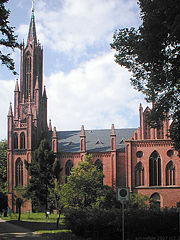
Malchow Abbey
Encyclopedia

Mecklenburgische Seenplatte (district)
Mecklenburgische Seenplatte is a district in the southeast of Mecklenburg-Vorpommern, Germany. It is bounded by the districts Ludwigslust-Parchim, Rostock , Vorpommern-Rügen, Vorpommern-Greifswald, and the state Brandenburg to the south...
in Mecklenburg-Vorpommern, Germany
Germany
Germany , officially the Federal Republic of Germany , is a federal parliamentary republic in Europe. The country consists of 16 states while the capital and largest city is Berlin. Germany covers an area of 357,021 km2 and has a largely temperate seasonal climate...
. The monastic buildings are on the east shore of the Malchower See (Lake Malchow) and now accommodate the Mecklenburgisches Orgelmuseum.
History
In 1298 the Cistercian nunnery formerly situated at RöbelRöbel
Röbel is a municipality in the Mecklenburgische Seenplatte district, in Mecklenburg-Western Pomerania, Germany. It is situated on the western shore of Lake Müritz, 25 km north of Wittstock, and 27 km southwest of Waren.-Sights:...
settled in Alt-Malchow and took over the premises of the former Magdalene community here. Nicholas I, Prince of Werle
Werle
Werle was a fiefdom, or Herrschaft in German, in the Holy Roman Empire that was founded in 1235. It was created in the partition of territories in Mecklenburg that followed the death of Henry Borwin II of Mecklenburg ....
, gave the new nunnery the patronage of the churches at Alt-Malchow, Neu-Malchow and Lexow (in Walow
Walow
Walow is a municipality in the Mecklenburgische Seenplatte district, in Mecklenburg-Vorpommern, Germany....
). After the Reformation
Protestant Reformation
The Protestant Reformation was a 16th-century split within Western Christianity initiated by Martin Luther, John Calvin and other early Protestants. The efforts of the self-described "reformers", who objected to the doctrines, rituals and ecclesiastical structure of the Roman Catholic Church, led...
the abbey was a collegiate foundation for noblewomen (Damenstift) from 1572 to 1923.
Buildings
The former abbey building complex is now dominated by the church, which was built between 1844 and 1849 to plans by Friedrich Wilhelm Buttel. These included a 52-metre high brick tower, after the addition of which it was thought necessary to refurbish the naveNave
In Romanesque and Gothic Christian abbey, cathedral basilica and church architecture, the nave is the central approach to the high altar, the main body of the church. "Nave" was probably suggested by the keel shape of its vaulting...
for aesthetic reasons. Before 1844 the church was a simple stone building.
After a fire in 1888 the church was rebuilt in a Gothic Revival between 1888 and 1890 according to plans by Georg Daniel.
Of the old abbey buildings there still exist the cloister
Cloister
A cloister is a rectangular open space surrounded by covered walks or open galleries, with open arcades on the inner side, running along the walls of buildings and forming a quadrangle or garth...
, as well as some ancillary buildings now used for residential purposes.
Mecklenburgisches Orgelmuseum
In the abbey church and the nearby organOrgan (music)
The organ , is a keyboard instrument of one or more divisions, each played with its own keyboard operated either with the hands or with the feet. The organ is a relatively old musical instrument in the Western musical tradition, dating from the time of Ctesibius of Alexandria who is credited with...
courtyard is a permanent exhibition relating to the history of organ-building in Mecklenburg
Mecklenburg
Mecklenburg is a historical region in northern Germany comprising the western and larger part of the federal-state Mecklenburg-Vorpommern...
. The Mecklenburg Organ Museum (Mecklenburgisches Orgelmuseum) is the first of its sort in the new Bundesländer
States of Germany
Germany is made up of sixteen which are partly sovereign constituent states of the Federal Republic of Germany. Land literally translates as "country", and constitutionally speaking, they are constituent countries...
. In the abbey church itself there is an organ by Friedrich Friese III.

